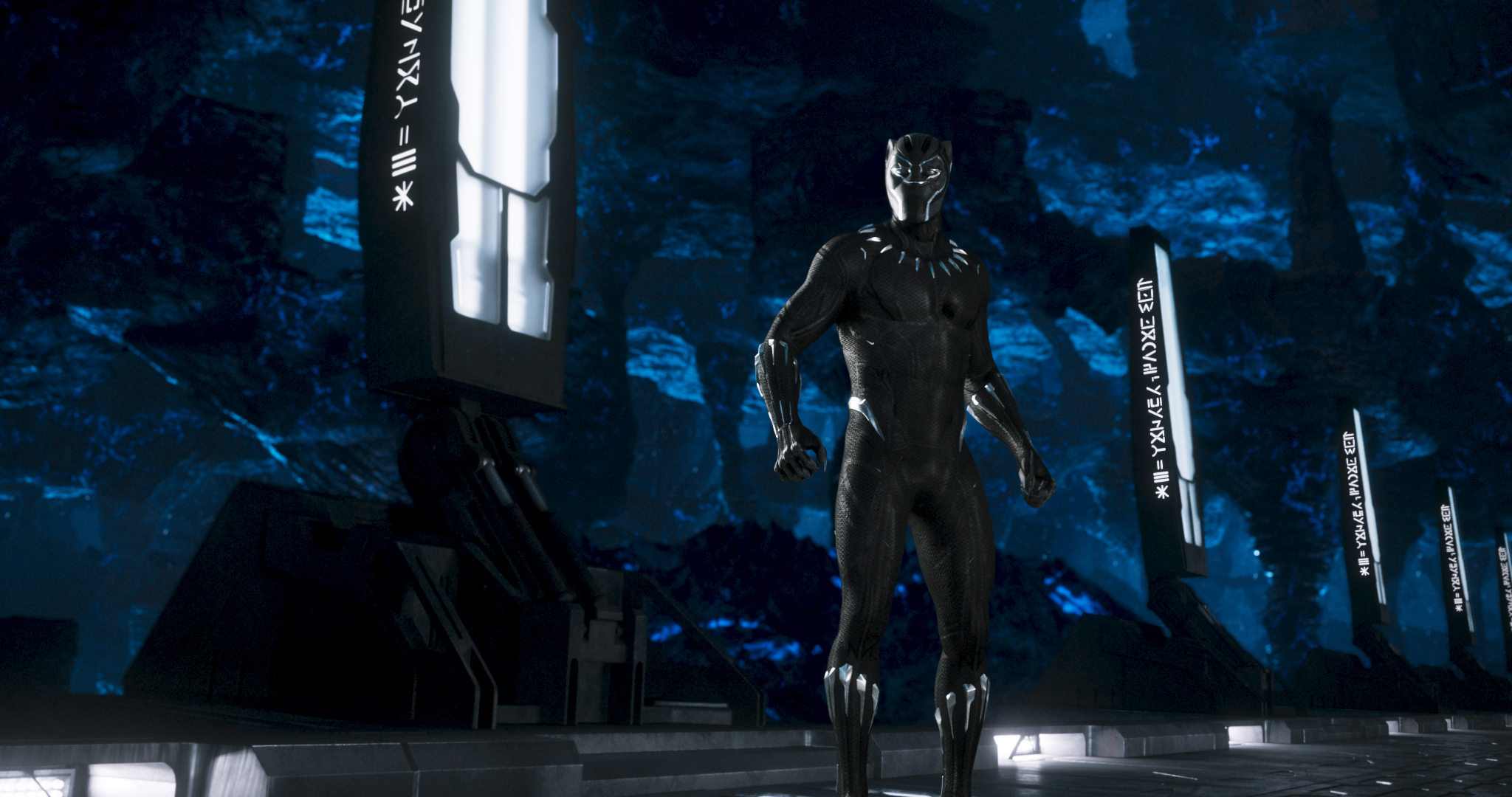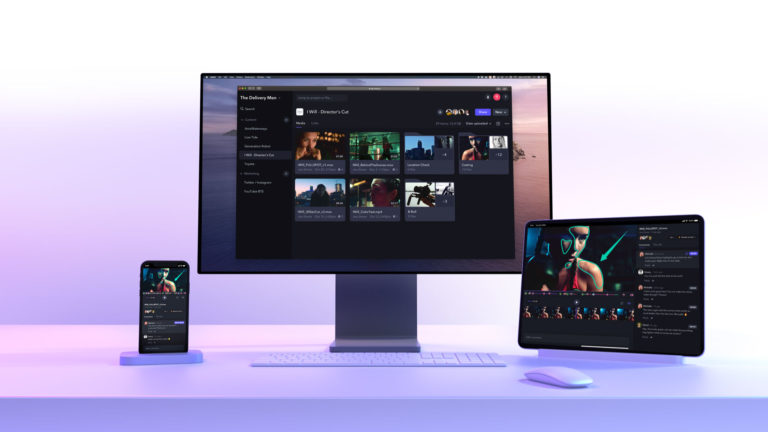What’s it like to work with Black Panther director Ryan Coogler? Collaboration is the keyword. At an NAB 2018 Creative Master Series panel considering Black Panther‘s storytelling techniques, editor Michael P. Shawver, VFX supervisor Geoffrey Baumann, and sound designer/supervisor and re-recording mixer Steve Boeddeker indicated that the filmmaker is unusually concerned with the feedback and ideas from his entire crew, as well as members of the audiences who test-screen his pictures. “It was the talk of Skywalker Sound that they invited everyone from the sound department to screen the rough assembly,” recalled Boeddeker. “They invited everybody, and then we all sat around and discussed it. Everybody felt a part of that project. That’s just the way [Coogler] operates.” Shawver, the film editor who has worked with Coogler since film school, agreed. “Ryan wants everyone to tell their own story and put their own experience into the project,” he said, adding that Coogler often communicates in terms of audiences’ emotional response to a film, explaining how he wants viewers to feel at different points in the narrative process. Watch this excerpt from the discussion, provided by NAB Show, or read on for our own takeaways from the panel, which considered how editorial decisions, VFX work, and sound design all came together to help take the audience on a record-breaking cinematic journey.
Being an effective editor means more than being a speed demon on the Avid. “Editing is less than 40% actually editing and pushing the buttons. A lot of it is having discussions. A lot of it is considered therapy, for difficult times,” admitted Shawver. But the most important function editors serve, he suggested, is as an intermediary between the film’s director and its viewers. “Basically, editors are the liaison for the audience. Our job is to make sure you guys have the best experience.”
Storytelling doesn’t have to take a back seat to action. Early versions of the film’s first fight scene at Warrior Falls, in which a rival challenges T’Challa’s claim to the Wakandan throne, fell a little flat. T’Challa earned an important victory, but Shawver wasn’t sure it held enough of a narrative charge for the audience. In order to invest the brawl with some emotional impact, Shawver thought back to something he and Coogler had learned while making Creed, which led him to work harder on building more conflict into the edit, with back and forth moments as the two brawlers’ fortunes shifted. “The moments when you see T’Challah knocking M’Baku down, M’Baku actually fell during those takes,” Shawver revealed. “I found ways to cut it together to make it look like T’Challa hit him or kicked him to knock him down. With the back and forth of it, the momentum builds.”

L to R: Okoye (Danai Gurira), Nakia (Lupita Nyong’o) and Ayo (Florence Kasumba) in Black Panther
Matt Kennedy ©Marvel Studios 2018
The right reaction shots raise the stakes. Another addition Shawver made to that fight scene was cuts to the spectators, which showed how involved and engaged the people T’Challa loved were about his fate in the ring. “A fight is cool, but it doesn’t really feel emotional, like an experience you just went through, unless you show the story through the reactions of the people who love the people fighting,” he explained. “So in those small moments of victory and defeat T’Challa goes through, we cut to his mom, to his sister, to his ex-girlfriend, and all the important characters of the movie, and they help guide that experience. This is a story about one guy and his journey, but he is the figurehead of a nation. He represents those people, and his family, and that’s a strong theme here. When you feel like you went through a really tough thing with the character 20 minutes into the movie, it gives you that narrative momentum to push through the rest of the movie.”

Mining Tribe Elder (Connie Chiume) in Black Panther
Film Frame ©Marvel Studios 2018
Authentic African production design kept VFX on its toes. While a Marvel movie like Guardians of the Galaxy may have free rein in its otherworldly sci-fi designs, Black Panther was rooted in real cultural aesthetics, sometimes known collectively as afro-futurism, not to mention actual geographical locations. For example, the Warrior Falls environment was modeled on South Africa’s Oribi Gorge, but the Black Panther version doubles as a huge amphitheater where the cliff walls are lined with spectators from many different Wakandan tribes. The precisely designed and executed costumes made the job of crowd simulations somewhat more involved. “One of the challenges with these sprites, or CG characters, in particular is that Ruth Carter, our costume designer, had very unique and beautiful costumes,” said Baumann. “They weren’t something that you could simply copy and paste, because otherwise you’re going to see the same character [repeated] throughout. So they became much more complex builds for those characters.”
CG nips and tucks are important storytelling tools. Black Panther opens with a flashback to 1992 featuring T’Challa’s father, T’Chaka, who appears in full Black Panther garb. This was problematic at early friends-and-family screenings, where audience members didn’t necessarily realize T’Challa and T’Chaka were two different characters. “It’s a death wish if the audience is asking those kinds of questions within the first 10 minutes of the movie,” Shawver said. Rather than attempting a drastic re-edit, or even reshooting the footage, the team had the elegant idea of adding a touch of digitally applied grey to T’Chaka’s beard, making him look older. Changes to the gold trim of the suit he wore further differentiated his character from T’Challa. “You had the connection to T’Challa wearing the suit with the same helmet, and we realized that it became too confusing at that early stage,” Baumann added.
Sounds mean different things to different people. Steve Boeddeker described some ways sound was used to set the stage in a very practical sense — for example, the sound of BART trains was added to the background of scenes set in Oakland as a geographic indicator — but also noted that sound can introduce shades of meaning or even accidental ambiguity. “On one of the flashbacks, when it was announced that Killmonger as a boy was left behind, when we cut to him we had this boom sound that we called the Contentious Boom,” Boedekker said. “Depending on how you interpreted it, the boom was either signifying that something that he was bad, or that what they had done was bad. When we were mixing it, half of the room thought it was one way and half thought it was the other way. So we had the boom in and we took the boom out and we had the boom in and we took the boom out. This was with all the executives. We did this for probably 15 or 20 minutes. It took some very valuable time, but that’s the kind of collaboration that they encourage.”
Final result? The Contentious Boom stayed in the mix. Just something else to keep an ear open for next time you watch Black Panther.
Did you enjoy this article? Sign up to receive the StudioDaily Fix eletter containing the latest stories, including news, videos, interviews, reviews and more.










